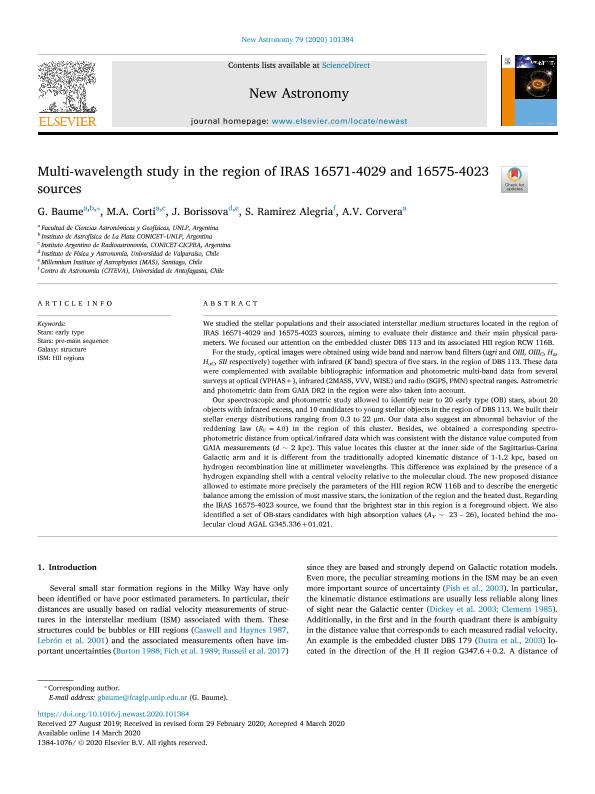Artículo
Multi-wavelength study in the region of IRAS 16571-4029 and 16575-4023 sources
Fecha de publicación:
08/2020
Editorial:
Elsevier Science
Revista:
New Astronomy
ISSN:
1384-1076
Idioma:
Inglés
Tipo de recurso:
Artículo publicado
Clasificación temática:
Resumen
We studied the stellar populations and their associated interstellar medium structures located in the region of IRAS 16571-4029 and 16575-4023 sources, aiming to evaluate their distance and their main physical parameters. We focused our attention on the embedded cluster DBS 113 and its associated HII region RCW 116B. For the study, optical images were obtained using wide band and narrow band filters (ugri and OIII, OIIIC, Hα, HαC, SII respectively) together with infrared (K band) spectra of five stars. in the region of DBS 113. These data were complemented with available bibliographic information and photometric multi-band data from several surveys at optical (VPHAS+), infrared (2MASS, VVV, WISE) and radio (SGPS, PMN) spectral ranges. Astrometric and photometric data from GAIA DR2 in the region were also taken into account. Our speectroscopic and photometric study allowed to identify near to 20 early type (OB) stars, about 20 objects with infrared excess, and 10 candidates to young stellar objects in the region of DBS 113. We built their stellar energy distributions ranging from 0.3 to 22 µm. Our data also suggest an abnormal behavior of the reddening law (RV=4.0) in the region of this cluster. Besides, we obtained a corresponding spectrophotometric distance from optical/infrared data which was consistent with the distance value computed from GAIA measurements (d ~ 2 kpc). This value locates this cluster at the inner side of the Sagittarius-Carina Galactic arm and it is different from the traditionally adopted kinematic distance of 1-1.2 kpc, based on hydrogen recombination line at millimeter wavelengths. This difference was explained by the presence of a hydrogen expanding shell with a central velocity relative to the molecular cloud. The new proposed distance allowed to estimate more precisely the parameters of the HII region RCW 116B and to describe the energetic balance among the emission of most massive stars, the ionization of the region and the heated dust. Regarding the IRAS 16575-4023 source, we found that the brightest star in this region is a foreground object. We also identified a set of OB-stars candidates with high absorption values (AV ~ 23 ? 26), located behind the molecular cloud AGAL G345.336+01.021.
Archivos asociados
Licencia
Identificadores
Colecciones
Articulos(IALP)
Articulos de INST.DE ASTROFISICA LA PLATA
Articulos de INST.DE ASTROFISICA LA PLATA
Citación
Baume, Gustavo Luis; Corti, Mariela Alejandra; Borissova, J.; Ramirez Alegria, S.; Corvera, A. V.; Multi-wavelength study in the region of IRAS 16571-4029 and 16575-4023 sources; Elsevier Science; New Astronomy; 79; 8-2020; 101384, 1-15
Compartir
Altmétricas




